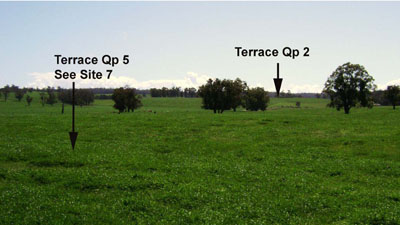EGW7
Location: Jarramond
Australian Soil Classification: Bleached-Sodic, Magnesic, Grey KUROSOL (very thick loamy surface horizons)
Map Unit: River terrace (Component 5)
Previous Site Name: EG7
General Landscape Description: Alluvial terrace
Site description: Upper terrace <1% slope
Land Use: Grazing
Geology: Quaternary alluvium (Qp5)

Soil Profile Morphology:
| Surface soil | |||
A1 | 0 – 5 cm | Dark greyish brown (10YR4/2); loam; weak consistence moist; pH 5.4; clear change to: | |
A21 | 5 – 30 cm | Greyish brown (10YR5/2); silty loam; weak consistence moist; pH 5.1; gradual change to: | |
A22 | 30 – 50 cm | Greyish brown (10YR5/2); silty clay loam; weak coarse prismatic structure; weak consistence moist; pH 5.4; gradual change to: | |
Subsoil | |||
B21 | 75 – 105 cm | Greyish brown (10YR5/2); medium clay; weak coarse prismatic structure; firm consistence moist; pH 5.3. | |
Key Profile Features:
- Deep silty clay loam surface horizons.
- Texture contrast between the deep surface (A) horizons and the more clayey subsoil (B) horizon.
Soil Profile Characteristics:
- | pH | Salinity | ||
Surface soil (A11 horizon) | Strongly acid | Very low | Non Sodic | None1 |
Subsurface (A12 horizon) | Strongly acid | Very low | Sodic | None2 |
Deeper subsoil (75-105cm) | Strongly acid | Low | Sodic | None2 |
Chemical and Physical Analysis:
Horizon | Horizon Depth (cm) | pH (water) | pH (CaCl2) | EC dS/m | Organic Carbon % | Total Nitrogen % | Exchangeable Aluminium ppm | Exchangeable Acididty meq/100g | Exchangeable Cations | Coarse Sand (0.2-2.0 mm) % | Fine Sand (0.02-0.2 mm) % | Silt (0.002-0.02 mm) % | Clay (<0.002 mm) % | Field Capacity % w/w | Wilting Point % w/w | |||
Ca | Mg | K | Na | |||||||||||||||
meq/100g | ||||||||||||||||||
A21 | 5-30 | 5.4 | 4.5 | 0.1 | 2.5 | 0.22 | 18 | 12.0 | 2.4 | 2.1 | 0.71 | 0.35 | 2 | 51 | 25 | 15 | 25.4 | 11.2 |
A22 | 30-50 | 5.1 | 4.3 | 0.1 | 80 | 8.4 | 0.52 | 1.9 | 0.42 | 0.43 | 1 | 52 | 27 | 18 | ||||
A23 | 50-75 | 5.4 | 4.3 | 0.11 | 0.77 | 0.05 | 77 | 7.5 | 0.17 | 2.1 | 0.44 | 0.72 | 1 | 52 | 27 | 18 | ||
B21 | 75-105 | 5.3 | 4.4 | 0.21 | 180 | 10.0 | 0.14 | 5.7 | 0.55 | 1.9 | 1 | 40 | 21 | 38 | ||||
Management Considerations
Surface (A) Horizons
- The surface soil is strongly acid, but is unlikely to show any response to lime.
- As the surface soils have high fine sand and silt content they tend to set when wet following cultivation and subsequent irrigation unless the organic matter is maintained.
- The surface horizons have low inherent fertility (based on the sum of the exchangeable cations).
- The surface soil is quite high in potassium and no response to potassium fertilisers would be expected.
- Moderate levels of exchangeable aluminium in surface horizons.
Subsoil (B) Horizon
- Sodic subsoils are typically moderately to strongly dispersive, but here are slightly dispersive. This is because of the high exchangeable aluminium (180 ppm).
- The cations are dominated by exchangeable magnesium which may create nutrient imbalances.
- The level of soluble salts is low.
- High exchangeable aluminium in the subsoil
- The sodic nature of the subsoil is unlikely to affect plants as is it too deep for all except deep rooted species, eg lucerne. Lucerne would also be adversely affected by the high levels of aluminium.
Profile Described By: David Rees and Grant Boyle, 2000.


